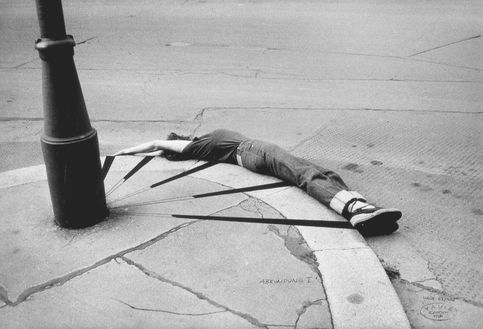Aus der Serie "Körperkonfigurationen"

VALIE EXPORT
Aus der Serie "Körperkonfigurationen", 1972-76
"Fotografiken"
"Photographics" 5 black-and-white photographs, vintage prints, reworked with India ink or red water color approx. 41.8 x 60.9 cm / 61 x 41.8 cm each, framed 56 x 79 cm / 79 x 56 cm each
WG0030304.00.0-1999
Artwork text
Since 1972, my drawings, photographs, and actions have been concerned with the presentation of postures as the expression of inner states, represented both in nature and in architecture as adaptation, assimilation, imposition, etc. in or on the environment. Parallels such as landscape and mind, architecture and mind, are mediated by the body, partly because the parallels have their origin in every extreme opposition of body and mind, and partly because the body is a revelation, as is landscape. Landscape is a revelation of space and time, or, more precisely, the arrangement of its elements, such as trees, rocks, hills, etc. are that. Arrangements of the body’s elements are postures, revelations, or expressions of inner states; this analogy between arrangements of landscape and body, these common forms of revelation, have served visual art from the beginning as surfaces for projecting expression: external configurations, whether in the landscape or in a picture (which thus becomes landscape) serve as an expression of internal states. This is why landscape is no less common as a motif in painting (and film) than the body. This is why people speak of “scenic atmospheres.” A landscape represents an atmosphere, just as body posture expressions do. Expressions are formed not only by the face. So a state of mind can be expressed first by the configuration of landscape components, secondly by the configuration of body components and thirdly—which is the innovation in my work— by the configuration of body elements in the landscape. In a second stage, the expression manifested in certain postures is examined in its historical forms. In the paintings of past times, unobserved, an archive of bodily postures has been collected which is of great expressive and informative value in examining the emotional states and mythologies of their eras. It turns out that these frozen motions of the body represent a canon, a doctrine. When I imitate these old postures I try more or less to perform an operation to draw out the expression, to make it independent, by assembling the postures with contemporary materials, thus trying to reveal these expressions. (Critical activity). At present I am mainly treating female postures from a feminist point of view and dealing with materials from the female environment, in order to thaw the imposed norms of the female bodily gestures, body language, and the associated function of the female body in our culture. (VALIE EXPORT)





